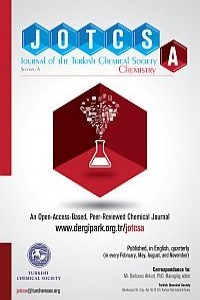Removal of Cu (II) Ions from Aqueous Solution Using Poly-Amidoxime Resin from Grafted Millet Husk Cellulose
Poly-amidoxime ligand was synthesized on the cellulose isolated from millet husk through a graft copolymerization process for adsorption of Cu (II) ion from aqueous solution. The functional group, thermal degradation and morphology of the adsorbent were investigated by Fourier transform infrared (FTIR), thermal gravimetric analysis (TGA) and scanning electron microscope (SEM), respectively. The FTIR results showed that grafting was successful due to the presences of 2244 cm-1 for cyano group (CN) and also band at 1640 cm-1 and 1380 cm-1 that replaced 2244 cm-1 which successfully confirmed the synthesis of poly(amidoxime) functional group. The TGA showed two stages of thermal degradation 12 % weight loss observed in amidoxime at 240 0C which is due degradation of amidoxime functional group then it reduces to 2% in second stage at 530 0C which revealed the improved thermal stability of the material. The SEM image showed a clear morphology of the absorbent before adsorption and after adsorption. The Initial concentration, adsorbent dosage and contact time were taken as independent variables. The adsorption process was optimized by central composite design (CCD) in Response surface methodology (RSM). The predicted value is in good agreement with experimental value and also the ANOVA result showed that all the independent variables have significant impact with the adsorbent. The optimum condition achieved in the experiment was at initial concentration of 150 mg/L, adsorbent dosage of 0.3 g and contact time of 90 min for Cu2+ with percentage removal of 55.41 % predictably and 54.92 % experimentally.
___
- 1. Bailey SE, Olin TJ, Bricka RM, Adrian DD. A review of potentially low-cost sorbents for heavy metals. Water Research. 1999 Aug;33(11):2469–79.
- 2. Nuhoglu Y, Oguz E. Removal of copper(II) from aqueous solutions by biosorption on the cone biomass of Thuja orientalis. Process Biochemistry. 2003 Jun;38(11):1627–31.
- 3. Crini G. Non-conventional low-cost adsorbents for dye removal: A review. Bioresource Technology. 2006 Jun;97(9):1061–85.
- 4. Gupta VK, Suhas. Application of low-cost adsorbents for dye removal – A review. Journal of Environmental Management. 2009 Jun;90(8):2313–42.
- 5. Seko N, Katakai A, Tamada M, Sugo T, Yoshii F. Fine Fibrous Amidoxime Adsorbent Synthesized by Grafting and Uranium Adsorption–Elution Cyclic Test with Seawater. Separation Science and Technology. 2004 Jan 12;39(16):3753–67.
- 6. Kaya B. Amidoksime-polimer ağyapılar ile bakır(II) iyonu adsorpsiyonu. Int J Multidis Stud Innov Technol. 2019;3(2):151–6.
- 7. Mahdavinia GR, Shokri E. Synthesis and characterization of magnetic amidoximated chitosan-g poly(polyacrylonitrile)/laponite RD nanocomposites with enhanced adsorption capacity for Cu$^{2+}$. Turk J Chem. 2017;41:135–52.
- 8. Anirudhan TS, Divya L, Bringle CD, Suchithra PS. Removal of Copper(II) and Zinc(II) from Aqueous Solutions Using a Lignocellulosic-Based Polymeric Adsorbent Containing Amidoxime Chelating Functional Groups. Separation Science and Technology. 2010 Nov;45(16):2383–93.
- 9. Coşkun R, Soykan C. Preparation of amidoximated polyester fiber and competitive adsorption of some heavy metal ions from aqueous solution onto this fiber. J Appl Polym Sci. 2009 May 5;112(3):1798–807.
- 10. Rahman L, Silong S, Zin WM, Rahman MZA, Ahmad M, Haron J. Graft copolymerization of methyl acrylate onto sago starch using ceric ammonium nitrate as an initiator. J Appl Polym Sci. 2000 Apr 25;76(4):516–23.
- 11. Abdel-Aziz HM. γ-radiation-induced preparation of polyamidoxime resins and their adsorption of methyl violet. J Appl Polym Sci. 2011 May 5;120(3):1547–54.
- 12. Rahman ML, Sarkar S, Yusoff M, Kulkarni A, Chowdhury Z, Ali ME. Poly(amidoxime) from Polymer-Grafted Khaya Cellulose: An Excellent Medium for the Removal of Transition Metal Cations from Aqueous Solution. BioResources. 2016;11(3):6780–800.
- 13. Pan Y, Wang F, Wei T, Zhang C, Xiao H. Hydrophobic modification of bagasse cellulose fibers with cationic latex: Adsorption kinetics and mechanism. Chemical Engineering Journal. 2016 Oct;302:33–43.
- 14. Rahman ML, Fui CJ, Sarjadi MS, Arshad SE, Musta B, Abdullah MH, et al. Poly(amidoxime) ligand derived from waste palm fiber for the removal of heavy metals from electroplating wastewater. Environ Sci Pollut Res. 2020 Sep;27(27):34541–56.
- 15. Garba ZN, Bello I, Galadima A, Lawal AY. Optimization of adsorption conditions using central composite design for the removal of copper (II) and lead (II) by defatted papaya seed. Karbala International Journal of Modern Science. 2016 Mar;2(1):20–8.
- 16. Bayuo J, Abukari MA, Pelig-Ba KB. Optimization using central composite design (CCD) of response surface methodology (RSM) for biosorption of hexavalent chromium from aqueous media. Appl Water Sci. 2020 Jun;10(6):135.
- 17. Gottipati R, Ecocarb G, Rourkela T. Application of response surface methodology for optimization of Cr (III) and Cr (VI) adsorption on commercial activated. Res J Chem Sci. 2012;2:40–8.
- 18. Basaleh AA, Al-Malack MH, Saleh TA. Methylene Blue removal using polyamide-vermiculite nanocomposites: Kinetics, equilibrium and thermodynamic study. Journal of Environmental Chemical Engineering. 2019 Jun;7(3):103107.
- Başlangıç: 2014
- Yayıncı: Türkiye Kimya Derneği
Sayıdaki Diğer Makaleler
Dhuha MOHAMMAD, Wassan BAQİR ALİ
Aisyah LARASATY SUSANGKA, Sutopo HADI, Noviany NOVİANY, Agung A. KİSWANDONO, Nurhasanah NURHASANAH, Kamisah D. PANDİANGAN
Rabia Zeynep KOBAK, Barbaros AKKURT
Nevin TAŞALTIN, Elif TÜZÜN, Selcan KARAKUŞ
Ganna SYROVA, Valentina PETİUNİNA, Olena SAVELİEVA, Tetyana TİSHAKOVA, Larysa LUKİANOVA
